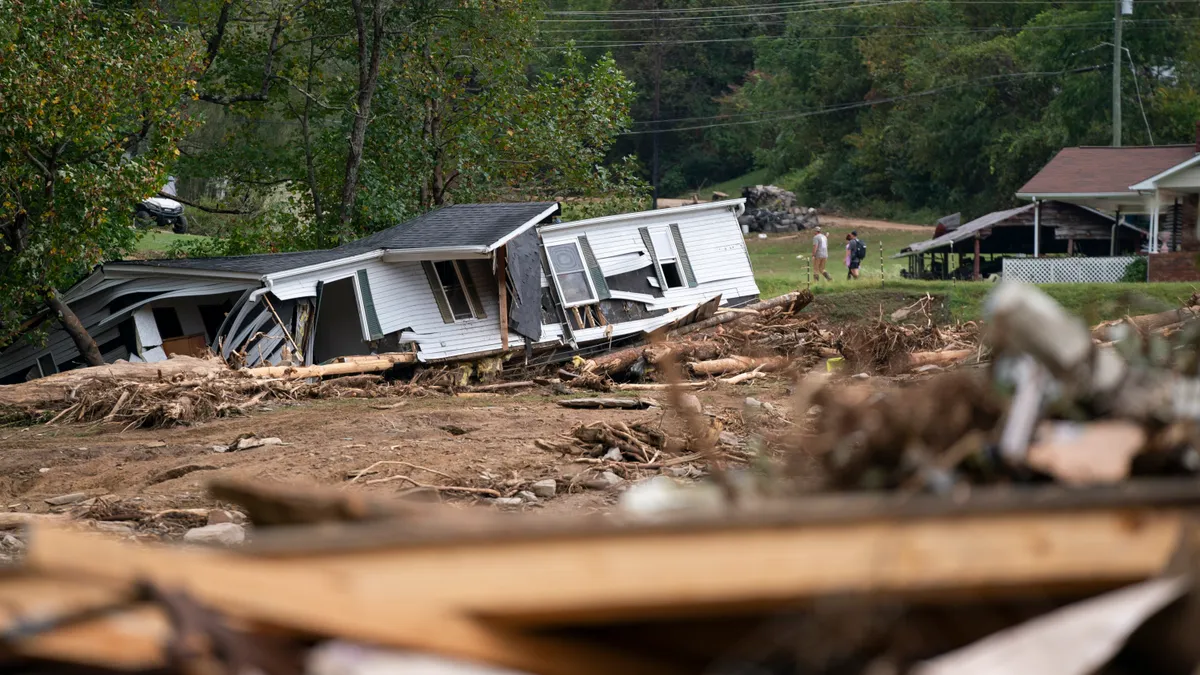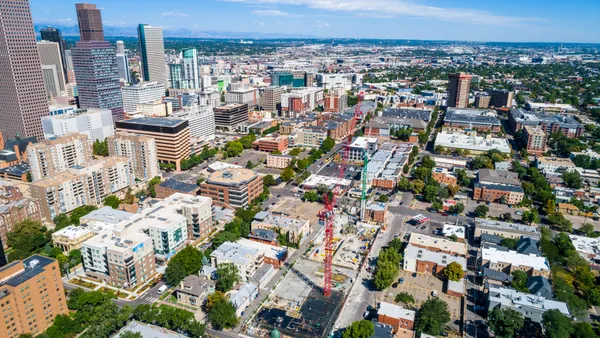Perusing lists of cities that won nationwide grant competitions can become a bit monotonous, with the same large cities appearing time and again. But small cities enter competitions and win grants, too, and their leaders say the funding might hold more significance for them than a larger city with more available resources.
This year’s nine winners of Bloomberg Philanthropies' Mayors Challenge included three cities — Georgetown, TX, Huntington, WV and New Rochelle, NY — with populations of less than 100,000, but all pursuing innovative ideas. Like all the winners, the cities receive $1 million to implement their ideas with guidance provided along the way from Bloomberg Philanthropies experts.
Smart Cities Dive spoke with leaders in these three cities about their winning ideas, the problems they’re trying to solve and what the grant means to the community.
Georgetown, TX
Population: 71,000
Winning idea: Energy independence through residential solar panels
Georgetown had a goal of becoming energy independent, but transporting renewable energy over long distances from generation sites to the city presented challenges with safety, reliability and cost. Leaders landed on the idea of leasing residents’ rooftops for solar panel installation, and energy would be stored in batteries on the residential properties.
The municipal grant recipients are required to get public feedback and hone their program ideas based on public input. This public engagement process caused Georgetown's energy concept to evolve.
"Focus groups really latched onto the ancillary benefit that if you have a solar panel and battery on your property, it automatically acts as a backup power source," said Georgetown Assistant to the City Manager Jack Daly. "It flipped our initial idea. We adjusted our whole approach to the program to be able to deliver backup power to people in exchange for placing batteries and solar panels on their property."
“For a major metropolitan area, $1 million is a rounding error. But if you give Georgetown $1 million, we could maybe change the world."

Jack Daly
Assistant to the City Manager, Georgetown, TX
Engaging the public and receiving feedback early and throughout the program creation was in itself a beneficial learning process for Georgetown leaders.
"It’s very different from how governments typically work. Usually we go off in our own corner and work out a solution and then present it to the public, and often everyone hates it," Daly said. "This is a refreshing approach … for a better product and more community buy-in."
The public buy-in has been huge for this project, Daly said. “It's frustrating in a good way because people keep calling and wanting to participate, and we have to say we’re not quite there yet, we’re developing the program right now.”
With the money from the pilot project, the city will need to hire a project manager, do additional design work and finalize the system architecture. The city anticipates the award money will fund solar panels for about 15 different homes and install about nine batteries. “That’s enough to power a whole neighborhood,” Daly said. “The intent is this will be a working prototype that the community can invest in going forward.”
The grant funding and guidance from the competition organizers has proven to be particularly productive and meaningful for Georgetown because it provided tools and approaches leaders previously did not have knowledge of or have access to.
“For a major metropolitan area, $1 million is a rounding error. But if you give Georgetown $1 million, we could maybe change the world,” Daly said.
Huntington, WV
Population: 47,000
Winning idea: Mitigating first responder compassion fatigue related to the opioid crisis
West Virginia is one of the states hardest hit by the national opioid crisis, and Huntington leaders recognized some members of the community have grown frustrated with the local overdose rate, leading to harsh comments toward addicts. Compassion fatigue also became evident among the city’s first responders who handle the frequent opioid calls.
"We knew compassion fatigue was real… It’s something that no matter what size your community is, all first responders deal with," said Huntington City Manager Cathy Burns. This could especially be the case for those who have personal experiences with opioids, such as loved ones fighting addiction.
Huntington leaders initially wanted to leap in and offer better opioid education and training for first responders, to help them understand the severity and challenges of the addiction. But the idea changed when leaders listened to feedback at listening sessions. "That’s the beauty of this grant and the whole program, the test and learn approach," Burns said, noting that such testing with public funds is a harder sell.
Leaders found first responders "were on the front lines and they were tired… we first had to show them compassion,” Burns said. "Someone gave the analogy of being on an airplane in an emergency, you have to administer oxygen to yourself first, instead of to a person near you."
The city collaboratively landed on a model of showing first responders appreciation and options for relieving stress, before imposing the educational component. The city now offers activities including yoga, massages and family pottery classes, which Burns says are "things to give them a positive outlet instead of a negative outlet, like maybe drinking too much."
Each department now has a “wellness coordinator,” a trusted confidant who offers referrals for counseling and mental health services. First responders will go through additional opioid training, including with a physician from a local hospital who explains the brain science of opioid addiction. And a main outcome has been restructuring how new hires are trained, especially for traumatic incidents that involve opioids in which responders might be exposed to multiple deaths in a short period of time.
"That will be the long term solution — changing the policy for training and onboarding first responders,” Burns said.
She considers Huntington's small city status beneficial for implementing this kind of program because it offers extra opportunities for collaboration. Plus, the collaborative atmosphere can foster expansion of the compassion fatigue program into other sectors, such as hospital emergency rooms.
“We're large enough to have lot of resources, but small enough where it’s not uncommon to run into decision makers at the grocery store or know them personally. Those are important partners to have on board in order to be effective,” Burns said.
New Rochelle, NY
Population: 80,000
Winning idea: Open-source augmented reality app to showcase new developments and foster community engagement
A variety of factors contribute to citizens not being in the know when it comes to new buildings or public spaces under development in their communities. New Rochelle leaders thought there could be an app for that.
During the first iteration of the project, leaders thought virtual reality technology could assist city planners with city-backed project visualization and development. But during several rounds of consultations with the Mayors Challenge organizers, they decided "planners do have access to this technology, but citizens do not," said Ralph DiBart, executive director of the New Rochelle Business Improvement District. Thus was born the idea to make a public-facing virtual reality app.
The idea is to offer citizens an easy way to learn about new and ongoing projects and to participate in the development and approval processes. "We hope to develop an open-source app that allows anyone to access and interact with this information," DiBart said.
The digital platform will offer engagement opportunities on a few levels. Citizens will be able to access the app from wherever they are and see presentations about proposed projects, vote on proposals and submit comments to the city. Another possibility is for citizens to download information when they approach a site under development and learn what’s going on by interacting with the augmented reality presentation.
This could get citizens involved in a project’s early stages and change the metric of engagement “usually occurring far along or at the end of a planning or development process,” DiBart said.
The app is considered a win both for citizens and for the city, because “small cities are limited in their resources. We’re constrained by time and money so opportunities for public engagement are limited,” DiBart said.
"When New York or Los Angeles does a project, they have incredible visuals and 3D presentations and they can advertise all over. This is our small community's version of that."

Ralph DiBart
Executive Director, New Rochelle Business Improvement District
City employees and stakeholders acknowledge people lead busy lives and that those with age, physical or social barriers can’t show up to civic engagement meetings to be a part of the process. But removing those barriers by providing a digital platform could lead to broader participation.
“This is for inclusivity and making information accessible to all parts of the community. We were absolutely surprised at how animated and excited people were” about the app, DiBart said. During public engagement and testing phases, “one person said their friend is disabled and wants to be engaged but can't leave their home. Seniors came and experimented with the technology for first time and they got it. A mother got excited and got her two teenage sons to come and participate in government.”
New Rochelle leaders and stakeholders do not believe they could have undertaken this task without the grant and the guidance from competition organizers.
"We were fortunate to receive this grant. Smaller cities do not have the resources to take advantage of immersive technology for communicating with citizens and to develop the technology on their own," DiBart said. "When New York or Los Angeles does a project, they have incredible visuals and 3D presentations and they can advertise all over. This is our small community's version of that."




















